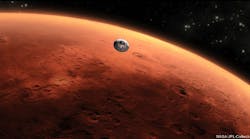NASA's Curiosity Triumphs with the Help of American Manufacturing, Technology
Today, NASA is celebrating the incredible success of what may be its most ambitious achievement since the lunar landing -- dropping its one-ton, $2.5 billion Mars Science Laboratory and Curiosity Rover safely on the surface of Mars.
The celebration began at 10:32 PST Sunday night when mission control issued the ecstatic announcement, “We are wheels down on Mars. Oh, my God.”
Now, as the nuclear-powered rover sets about its two-year mission hunting down signs of life on the red planet, congratulations are coming down from the highest levels of leadership for the technology and engineering contributors that helped make the success possible.
President Obama issued a statement shortly after the landing, noting that “the successful landing of Curiosity -- the most sophisticated roving laboratory ever to land on another planet -- marks an unprecedented feat of technology that will stand as a point of national pride far into the future.”
Charles Bolden, NASA administrator, added, “it is a huge day for the nation, it is a huge day for all of our partners who have something on Curiosity, and it is a huge day for the American people."
Included in these patriotic congratulations are the American manufacturers whose designs and products helped the project make it all the way to Mars.
Key among these manufacturers is ATK (IW 500/202), a Minneapolis-based aerospace, defense and commercial products company.
“We are extremely proud to have played a role in this incredible achievement for NASA and the Jet Propulsion Laboratory,” said Dianne Sosa, ATK vice president of Engineering Services. “We congratulate the NASA team for a successful landing and look forward to the key scientific findings that will help determine the potential for life on Mars.”
ATK's Technological Contributions
ATK has reason to be proud of this achievement -- the company has been heavily involved with every critical stage of the mission, from the launch in November 2011, though the nine-month flight to Mars, the descent to the surface and now into the exploration phase of the mission.
From the beginning, ATK’s Clearfield, Utah and Iuka Miss. made the Atlas V launch possible by building the lightweight composite heat shield, interstage adapter and boat tail sections of the rocket.
During the flight and, later, the decent, the rocket made the 352 million mile journey thanks to the five propellant tanks designed and built by ATK's Commerce, Calif. facility. Two of those rockets supplied propellant to cruise thrusters that guided the spacecraft on its journey to the red planet. ATK Engineering Services in Pasadena, Calif. supported the design development of the Terminal Descent Sensor, which guided the descent stage.
Over the next two years, the Curiosity rover will have access to key technical support for its research equipment thanks to ATK engineering teams in Pasadena, Calif. and Beltsville, Md. Some of these instruments -- including its Remote Sensing Mast Deploy Mechanism, as well as mechanical and thermal design and fabrication for the cornerstone Chemistry/Mineralogy (CheMin) instrument and Sample Analysis at Mars (SAM) tools -- share the same credit.
The success of the project through this critical stage is due in large part to ATK's extensive experience in aerospace and space travel, particularly in interplantetary delivery.
"We are honored to have been involved on almost every JPL/Mars mission," said Gary Kawahara, ATK vice president and general manager, Space Components Division, Liquid Propulsion Products. "ATK's diaphragm propellant tanks have demonstrated their reliability and safety on Mars programs from Mariner to Viking in the 1960s and 70s to the most recent Phoenix Lander. ATK has a perfect track record of more than 5,600 total tank deliveries with zero failures."
With Sunday night's safe landing and this perfect record still intact, ATK can now join NASA with a big sigh of relief, Kawahara says.
"As the journey to Mars is now complete and Curiosity is safely on the planet's surface, our job has successfully concluded."




